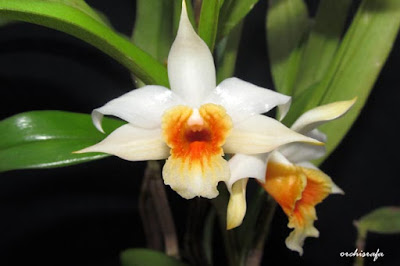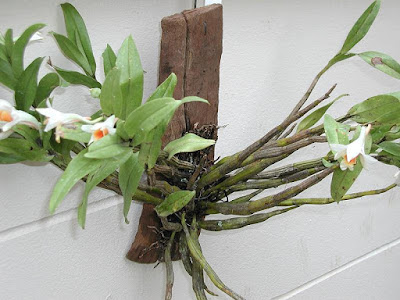Dendrobium cariniferum is widely distributed in Southeast Asia. Natural habitats extend from the mountains of north-eastern India, where these plants meet at heights of 1800 m, through Myanmar, Cambodia, Laos, Vietnam and southwestern China. In North-West Thailand plants meet at heights of 1100-1530 m.
Dendrobium cariniferum, also called as The Keel-Carrying Dendrobium, Callista carinifera, Dendrobium cariniferum var lateritium, is a species of the genus Dendrobium. This species was described by Heinrich Gustav Reichenbach in 1869.
IDENTIFY DENDROBIUM CARINIFERUM
Dendrobium cariniferum is widely distributed in Southeast Asia. Natural habitats extend from the mountains of north-eastern India, where these plants meet at heights of 1800 m, through Myanmar, Cambodia, Laos, Vietnam and southwestern China. In North-West Thailand plants meet at heights of 1100-1530 m.
It is miniature sized, hot to cool growing epiphyte, which can reach 25 cm in height, with thick, hirsute, 20 cm long stems carrying 4 to 6, broad, hirsute beneath, 5-8 cm leaves.
The Keel-Carrying Dendrobium blooms in the spring on a very short, apical inflorescence carrying 2 to 5, hirsute flowers that smell of oranges. The flowers are 3.8 cm in diameter and markedly bulging on the underside of the outer whale petals. These bulges extend in the form of sharp bulges up to the ovary. The width of the inner whorl flakes is almost equal to the width of the dorsolateral patch. The flowers may be pale buffalo with gold-yellow stripes on the scutellum, or the petals of both whorls may be white with brick-red spots on the lip. The lip along the veins is covered with villi and has a crest, which at the tip of the lip is divided into several parts.
DENDROBIUM CARINIFERUM CARE AND CULTURE
Cultural information should only be used as a guide, and should be to be adapted to suit you. Your physical location; where you grow your plants, how much time you have to devote to their care, and many other factors, will need to be taken into account. Only then can you decide on the cultural methods that best suit you and your plants.
Light:
Dendrobium cariniferum needs a light level of 25000-35000 lux. This plants grow better in bright, diffused light.
Temperature:
The average temperature of the summer day is 25-27 ° C, the night 18-19 ° C, giving a daily difference of 7-9 ° C. In spring, the average day temperature is 29-30 ° C, the night 11-18 ° C, which gives a daily difference of 11-18 ° C. In winter the average day temperature is 24-27 ° C, night 8-9 ° C, giving a daily difference of 15-18 ° C.
Humidity:
For most of the year, the humidity recommended is 75-85%, but at the end of winter and at the beginning of spring drops to almost 60%.
Substrate, growing media and repotting:
Dendrobium cariniferum can be grown mounted on tree-fern rootstocks or cork, high humidity is ensured and watering at least once a day in summer. When growing in pots, use any loose, quickly drying ground. Repotting is best done in early spring, immediately after flowering, when new roots grow.
Watering:
From late spring to early autumn, Dendrobium cariniferum should be abundantly watered with only slight, or not at all, drying between waterings. When new growths reach maturity in autumn, the amount of water should be gradually reduced.
Fertilizer:
Weekly use of a 1/2 dose of orchid fertilizer is recommended. From spring to mid summer, fertilizer with an increased nitrogen content is preferred, and fertilizer with an increased content of phosphorus should be used at the end of summer and autumn.
Rest period:
A cool, dry rest is very important for plants and should last until the appearance of new increments. You can complete elimination of water in winter, but Dendrobium cariniferum will be healthier, if during the most of the winter season they will dry out a little between waterings and not stay dry for too long. At the end of winter, however, for 1-2 months, the plants should dry completely between waterings and stay dry a little longer. Occasional morning fogging between waterings should protect the plant against excessive drying. Fertilization should be significantly reduced or eliminated until increased watering starts in the spring.















COMMENTS